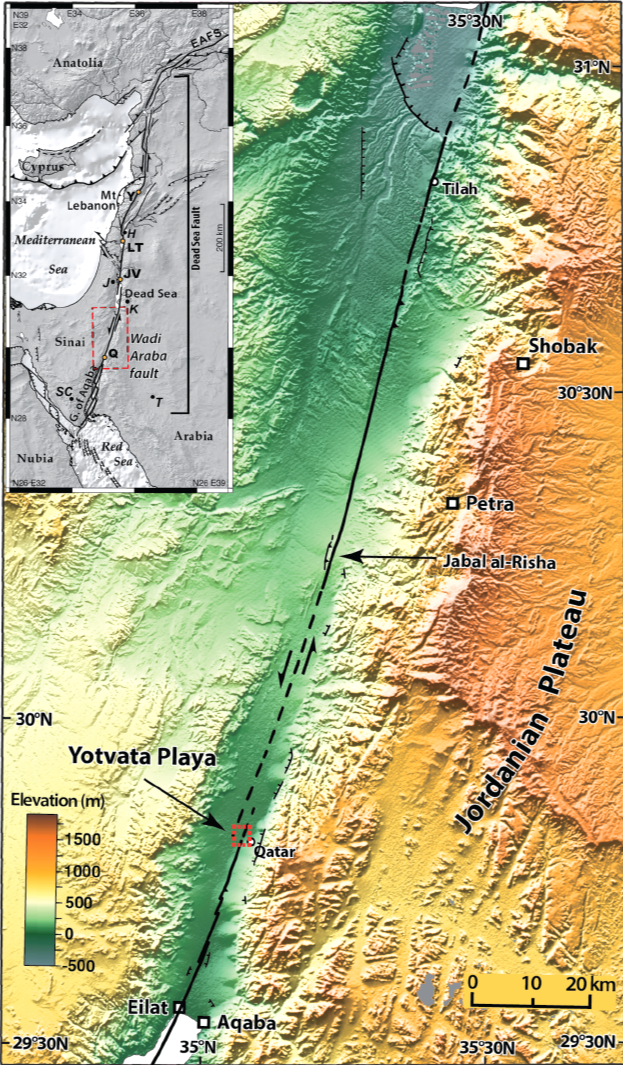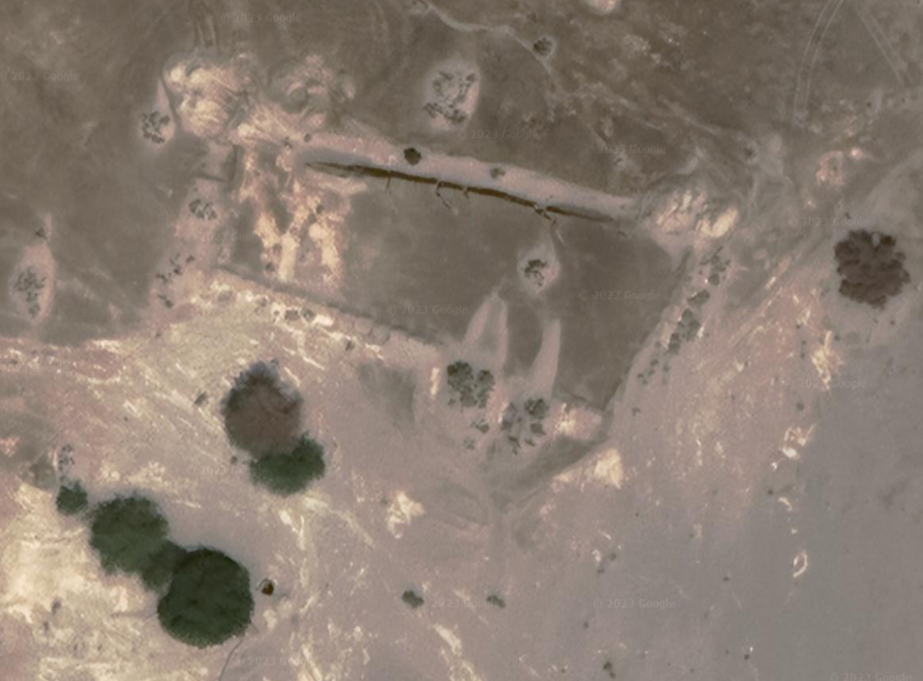Qatar Trench
 Figure 2
Figure 2Satellite image of the Qatar trench site (29°48′46.4″N, 35°04′26.3″E) at the Yotvata extensional jog. The push-ups are well visible at the southern tip of the relay zone, deforming the toe of alluvial fans. North of the trench, the fault can be located only from the pressure ridges (Fig. 3) that mark the flat playa deposits, and the offset shoreline. To the southwest the depression is limited by normal faults with minor vertical throw.
Background image is submetric pixel size imagery from Digital globe (Google Earth extract).
Click on Image to open a high resolution magnifiable version in a new tab
Klinger et al (2015)
Maps, Aerial Views, Trench Logs, and Age Model
Maps and Aerial Views
Normal Size
- Fig. 1 Location Map from
Klinger et al. (2015)

 Figure 1
Figure 1
nset map shows the entire Dead Sea fault, including major relay zones of the Dead Sea basin and the Lebanese bend. Y, LT, JV and Q indicate paleoseismological sites of Yammouneh, Lake Tiberias, Jordan Valley and Qatar, respectively. T, K, J, H and SC indicate cities of Tabuk, Al-Karak, Jerusalem, Hula basin and St Catherine monastery, respectively. EAFS stands for East Anatolia Fault System. The main figure shows the Wadi Araba fault segments after (Le Béon et al.2012), with location of the trench site in Yotvata Playa. The site of Tilah is also indicated. Dashed red box indicates Fig. 2.
Topography from SRTM3 (pixel size, ~90 m)
Klinger et al. (2015) - Fig. 2 Location Map (closeup)
from Klinger et al. (2015)

 Figure 2
Figure 2
Satellite image of the Qatar trench site (29°48′46.4″N, 35°04′26.3″E) at the Yotvata extensional jog. The push-ups are well visible at the southern tip of the relay zone, deforming the toe of alluvial fans. North of the trench, the fault can be located only from the pressure ridges (Fig. 3) that mark the flat playa deposits, and the offset shoreline. To the southwest the depression is limited by normal faults with minor vertical throw.
Background image is submetric pixel size imagery from Digital globe (Google Earth extract).
Click on Image to open a high resolution magnifiable version in a new tab
Klinger et al. (2015) - Location of the Qatar Trench in Google Earth
Magnified
- Fig. 1 Location Map from
Klinger et al. (2015)

 Figure 1
Figure 1
nset map shows the entire Dead Sea fault, including major relay zones of the Dead Sea basin and the Lebanese bend. Y, LT, JV and Q indicate paleoseismological sites of Yammouneh, Lake Tiberias, Jordan Valley and Qatar, respectively. T, K, J, H and SC indicate cities of Tabuk, Al-Karak, Jerusalem, Hula basin and St Catherine monastery, respectively. EAFS stands for East Anatolia Fault System. The main figure shows the Wadi Araba fault segments after (Le Béon et al.2012), with location of the trench site in Yotvata Playa. The site of Tilah is also indicated. Dashed red box indicates Fig. 2.
Topography from SRTM3 (pixel size, ~90 m)
Klinger et al. (2015) - Fig. 2 Location Map (closeup)
from Klinger et al. (2015)

 Figure 2
Figure 2
Satellite image of the Qatar trench site (29°48′46.4″N, 35°04′26.3″E) at the Yotvata extensional jog. The push-ups are well visible at the southern tip of the relay zone, deforming the toe of alluvial fans. North of the trench, the fault can be located only from the pressure ridges (Fig. 3) that mark the flat playa deposits, and the offset shoreline. To the southwest the depression is limited by normal faults with minor vertical throw.
Background image is submetric pixel size imagery from Digital globe (Google Earth extract).
Click on Image to open a high resolution magnifiable version in a new tab
Klinger et al. (2015)
Trench Logs
Location Maps
Klinger et al. (2015)
 Figure 2
Figure 2Satellite image of the Qatar trench site (29°48′46.4″N, 35°04′26.3″E) at the Yotvata extensional jog. The push-ups are well visible at the southern tip of the relay zone, deforming the toe of alluvial fans. North of the trench, the fault can be located only from the pressure ridges (Fig. 3) that mark the flat playa deposits, and the offset shoreline. To the southwest the depression is limited by normal faults with minor vertical throw.
Background image is submetric pixel size imagery from Digital globe (Google Earth extract).
Click on Image to open a high resolution magnifiable version in a new tab
Klinger et al (2015)
Trench Log
 Figure 5
Figure 5Trench log of the southern wall. The full resolution photomosaic of the wall is available in Fig. S1. The different stratigraphic units are indicated by letters A to H located in the synthetic stratigraphic section. Conservative position of event horizons are indicated with a dashed line, including for event Esuppl unambiguously visible in the eastern fault zone only. E8 is indicated for reference, although the dashed line corresponds to E7 event horizon (see discussion in text). Esupp2, between E8 and E9 is not indicated. Meter Marks (MM) are indicated above the trench. Dated 14C samples are indicated by star. To the west, a few samples have been collected up to 2 m outside the gridded wall, where the layers could be traced horizontally. Samples are indicated at the corresponding depth and stratigraphic position.
Klinger et al (2015)
Simplified Trench Log
 Figure 8
Figure 8Some of the earthquakes identified at our trench site have produced major deformation, while others are only responsible for small vertical offsets and cracks. The later are assumed to stop/start in the Yotvata jog and the large one to break through it. The trench suggests that the fault alternates between periods with more numerous smaller events and periods with large less frequent events. Potentially 2 cycles could be observed in this trench. Uv strands for vertical deformation. Chronological indications are located at corresponding stratigraphic level.
Klinger et al (2015)
Photomosaic
 Figure S1
Figure S1Photomosaic of the trench wall. Each square is 1 m per side
Klinger et al (2015)
Photo of the South Wall
Overview
 Figure 4a
Figure 4aOverview of the south wall of the trench. Numerous distinct layers of sand and silt are visible. The thinning of the whitish silt westwards corresponds to the main deformation zone with significant downdrop of the east compartment. White squares are 1 m aside for scale.
Klinger et al (2015)
Closeup on Meter Marker 5 (Flower Structure)
 Figure 4b
Figure 4bZoom on the stratigraphy at meter mark MM5 (Fig. 5). Faults are visible that offset the yellowish silt and grey sand layers in the upper part of the photograph. Rotated blocks are also visible in the lower part.
Klinger et al (2015)
Age Model
 Figure 6
Figure 6Age model computed for the trench stratigraphy using OxCal v4.2 (Bronk-Ramsey et al. 2010) and IntCal13 calibration curve (Reimer et al. 2013). Light grey indicates raw calibration and dark grey indicates modelled ages including stratigraphic information. Phases indicate subsets of samples where no stratigraphic order is imposed.
Klinger et al (2015)
Master Seismic Events Table
